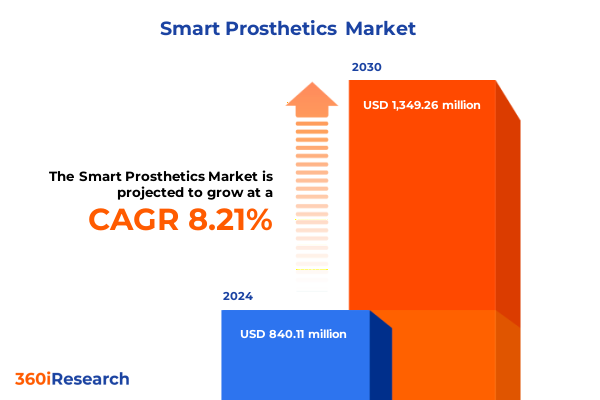The Smart Prosthetics Market size was estimated at USD 840.11 million in 2024 and expected to reach USD 906.39 million in 2025, at a CAGR 8.21% to reach USD 1,349.26 million by 2030.

Introduction: The Evolution and Promise of Smart Prosthetics
Smart prosthetics represent a paradigm shift in rehabilitative care, blending advanced robotics, embedded sensors, artificial intelligence, and secure connectivity to create devices that adapt to individual users in real time. This evolution has been propelled by breakthroughs in material science, sensor miniaturization, and machine‐learning algorithms that decode neural signals, enabling unprecedented levels of dexterity, comfort, and functional independence. At the same time, regulatory bodies such as the FDA and EMA are streamlining approval pathways for next-generation devices, while reimbursement frameworks are gradually adjusting to recognize the long-term cost–benefit of improved mobility and reduced care needs. As global demographics trend toward aging populations and rising incidence of limb loss from diabetes, trauma, and military service, demand for intelligent, user-centric prosthetic solutions is accelerating. This executive summary unpacks the critical technological inflection points, policy impacts, segmentation dynamics, regional growth drivers, leading market participants, and strategic directives that will define the trajectory of smart prosthetics over the coming decade.
Transformative Shifts Reshaping the Prosthetics Landscape
The smart prosthetics landscape is being transformed by a convergence of technological, clinical, and commercial shifts. Rapid advances in neural interface research are enabling AI-driven algorithms to translate residual muscle signals or cortical impulses into intuitive, multi‐degree‐of‐freedom control. Concurrently, additive manufacturing techniques such as high-resolution 3D printing are reducing lead times for custom sockets and end-effectors, making personalization scalable. Material innovations in carbon fiber composites, titanium alloys, and thermoplastic elastomers are driving dramatic improvements in strength-to-weight ratios and wearer comfort. At the system level, edge computing and secure wireless connectivity allow real-time diagnostics and firmware updates, fostering predictive maintenance and remote clinician collaboration. Reimbursement policies are evolving to accommodate outcome-based payment models, incentivizing providers to invest in solutions that demonstrate long-term cost savings. This intersection of innovation, policy adaptation, and patient empowerment is creating fertile ground for the next generation of prosthetic devices that seamlessly integrate with users’ lifestyles.
Assessing the Cumulative Impact of U.S. Tariffs in 2025
As of 2025, new U.S. tariff measures are targeting imported prosthetic components and raw materials, including aluminum, carbon fiber, silicone, and select electronics. These levies have introduced immediate cost pressures, particularly for manufacturers reliant on international supply chains in East Asia and Europe. Component suppliers are reassessing sourcing strategies, accelerating domestic production partnerships to mitigate exposure to tariff volatility. While some manufacturers have absorbed marginal cost increases to preserve price competitiveness, others have transferred incremental expenses to end users, potentially slowing adoption among price-sensitive patient populations. On the positive side, tariff-driven incentives have spurred investment in U.S.-based tooling and assembly facilities, fostering greater supply chain resilience. Ongoing trade negotiations and potential harmonization of HS codes could alleviate some burdens, but in the near term, strategic procurement planning and supplier diversification remain critical for navigating this shifting trade environment.
Key Segmentation Insights Driving Product and Channel Strategies
Analyzing the market through a product-based lens reveals distinct trajectories: lower body prosthetics, encompassing prosthetic ankles and knees, continue to benefit from innovations in load-bearing robotics and energy-return systems, while upper body prosthetics, including prosthetic arms and hands, are propelled by breakthroughs in multi-finger dexterity and haptic feedback. Material-driven segmentation shows carbon fiber commanding preference for its high strength-to-weight profile, with titanium and stainless steel providing structural integrity in high-load applications; silicone and thermoplastic elastomers are indispensable for skin-like comfort and socket suspension. From an end user perspective, hospitals spearhead initial device adoption due to integrated surgical and rehabilitative programs, prosthetic clinics refine patient-specific calibrations, and rehabilitation centers focus on long-term gait and functional training. Meanwhile, distribution channels are evolving: traditional offline networks maintain their prominence for clinical fittings and adjustments, even as online platforms expand direct-to-patient outreach with digital measurement tools and remote support.
This comprehensive research report categorizes the Smart Prosthetics market into clearly defined segments, providing a detailed analysis of emerging trends and precise revenue forecasts to support strategic decision-making.
- Product
- Material
- End User
- Distribution Channel
Key Regional Insights Highlighting Growth Frontiers
Geographically, the Americas region leads in adoption, underpinned by advanced healthcare infrastructure, robust reimbursement frameworks, and strong collaboration between research institutions and private firms. In Europe, Middle East & Africa, harmonized regulatory standards and growing public health funding are facilitating cross-border trials and pilot programs, particularly in the United Kingdom, Germany, and the United Arab Emirates. The Asia-Pacific landscape is marked by rapid growth driven by expanding healthcare access in China and India, increasing governmental initiatives to support disability inclusion, and the emergence of regional manufacturing hubs in Southeast Asia. While offline distribution channels dominate the Americas and EMEA, Asia-Pacific is experiencing swift digital transformation, with e-commerce platforms and telehealth services enabling remote fittings and real-time prosthetic adjustments. Each region’s unique regulatory, economic, and cultural context defines distinct opportunities for device customization, local partnerships, and targeted service offerings.
This comprehensive research report examines key regions that drive the evolution of the Smart Prosthetics market, offering deep insights into regional trends, growth factors, and industry developments that are influencing market performance.
- Americas
- Asia-Pacific
- Europe, Middle East & Africa
Key Company Insights Spotlighting Market Leadership
Leading innovators are shaping market dynamics through specialized expertise and strategic alliances. Advanced Arm Dynamics, Inc. and Mobius Bionics LLC are advancing upper-limb control systems with intuitive myoelectric interfaces, while Össur hf and Otto Bock HealthCare Andina Ltda dominate the lower-limb segment through energy-storing prosthetic feet and microprocessor knees. Open Bionics Ltd and Bionic Hope Private Limited are democratizing access with cost-effective, open-source hand designs that prioritize rapid customization. DEKA Research & Development Corp. and BrainRobotics are pioneering neural-link technologies that translate brain signals into refined prosthetic movement. College Park Industries and Steeper Group focus on cutting-edge socket and suspension systems that enhance interface comfort. WillowWood Global LLC and Shijiazhuang Perfect Prosthetic lead in material and liner innovations, optimizing skin compatibility and durability. Meanwhile, service-oriented providers such as Hanger Clinic and Fillauer LLC are integrating data-driven care models to improve patient outcomes. Collectively, these organizations are driving competitive differentiation through R&D investment, cross-domain partnerships, and expanding global footprints.
This comprehensive research report delivers an in-depth overview of the principal market players in the Smart Prosthetics market, evaluating their market share, strategic initiatives, and competitive positioning to illuminate the factors shaping the competitive landscape.
- Advanced Arm Dynamics, Inc.
- Bionic Hope Private Limited
- Bionic Prosthetics & Orthotics Group LLC
- Blatchford Limited
- BrainGate
- BrainRobotics
- College Park Industries
- COVVI
- DEKA Research & Development Corp.
- Endolite
- Fillauer LLC
- Gilde Healthcare Partners BV
- Hanger Clinic
- HDT Global
- Medical Center Orthotics & Prosthetics
- Mobius Bionics LLC
- Open Bionics Ltd
- Otto Bock HealthCare Andina Ltda
- Proactive Technical Orthopaedics Pvt Ltd.
- PROTEOR
- Shijiazhuang Perfect Prosthetic
- Steeper Group
- TASKA Prosthetics Limited
- WillowWood Global LLC.
- Össur hf
Actionable Recommendations for Industry Leaders
Industry leaders should prioritize several strategic imperatives to capitalize on emerging opportunities. First, intensify R&D efforts in AI-enabled control algorithms and haptic feedback to differentiate products in both lower and upper body segments. Second, diversify supplier networks and consider onshore production for critical components to mitigate tariff risks and ensure supply chain agility. Third, tailor patient engagement strategies by leveraging telehealth platforms and digital patient portals that facilitate remote fittings and post-sale support. Fourth, collaborate with payers and regulatory authorities to develop outcome-based reimbursement models that reward long-term functionality and cost savings. Fifth, invest in modular, upgradeable device architectures that allow incremental feature enhancements without full system replacement. Sixth, expand regional partnerships to localize manufacturing and distribution in high-growth territories such as Asia-Pacific. Lastly, cultivate clinician training programs and patient educational resources to accelerate adoption and compliance.
Explore AI-driven insights for the Smart Prosthetics market with ResearchAI on our online platform, providing deeper, data-backed market analysis.
Ask ResearchAI anything
World's First Innovative Al for Market Research
Conclusion: Navigating the Future of Smart Prosthetics
Smart prosthetics stand at the intersection of engineering ingenuity, clinical necessity, and evolving policy frameworks. As the market accelerates toward more personalized, connected solutions, stakeholders must navigate a complex tapestry of trade regulations, reimbursement models, and regional market idiosyncrasies. By integrating advanced materials, neuromuscular interfaces, and digital health platforms, device makers can deliver superior patient outcomes while safeguarding margins against tariff volatility. Collaborative ecosystems that unite technology firms, healthcare providers, and policymakers will be essential to scale innovations and drive equitable access. The path forward demands a balance of bold investment in next-generation capabilities and pragmatic strategies to optimize existing operations. With proper alignment of research, regulation, and commercialization efforts, smart prosthetics will redefine mobility and quality of life for millions worldwide.
This section provides a structured overview of the report, outlining key chapters and topics covered for easy reference in our Smart Prosthetics market comprehensive research report.
- Preface
- Research Methodology
- Executive Summary
- Market Overview
- Market Dynamics
- Market Insights
- Cumulative Impact of United States Tariffs 2025
- Smart Prosthetics Market, by Product
- Smart Prosthetics Market, by Material
- Smart Prosthetics Market, by End User
- Smart Prosthetics Market, by Distribution Channel
- Americas Smart Prosthetics Market
- Asia-Pacific Smart Prosthetics Market
- Europe, Middle East & Africa Smart Prosthetics Market
- Competitive Landscape
- ResearchAI
- ResearchStatistics
- ResearchContacts
- ResearchArticles
- Appendix
- List of Figures [Total: 24]
- List of Tables [Total: 283 ]
Call to Action: Unlock In-Depth Market Research with Ketan Rohom
To gain immediate access to comprehensive data, in-depth competitive analysis, and actionable market intelligence, reach out to Ketan Rohom, Associate Director of Sales & Marketing. Leverage his expertise to secure the full report, which delivers granular insights into segmentation dynamics, regional opportunities, tariff impacts, and strategic imperatives. Equip your organization with the knowledge required to make informed decisions and drive sustainable growth in the rapidly evolving smart prosthetics market. Contact Ketan Rohom today to discuss your specific informational needs and to arrange a personalized consultation.

- How big is the Smart Prosthetics Market?
- What is the Smart Prosthetics Market growth?
- When do I get the report?
- In what format does this report get delivered to me?
- How long has 360iResearch been around?
- What if I have a question about your reports?
- Can I share this report with my team?
- Can I use your research in my presentation?




